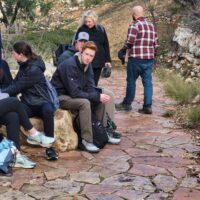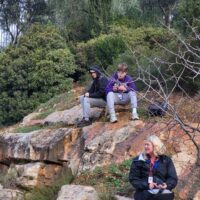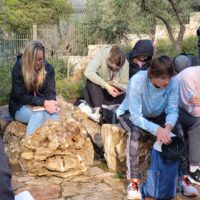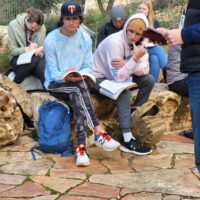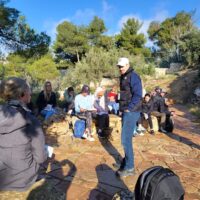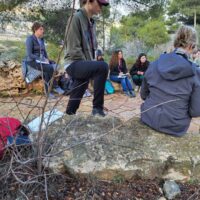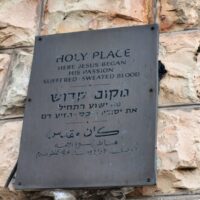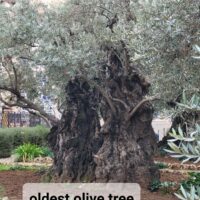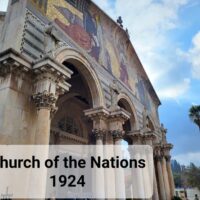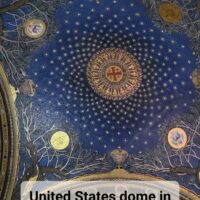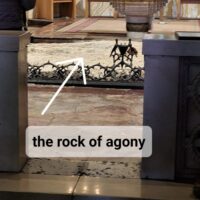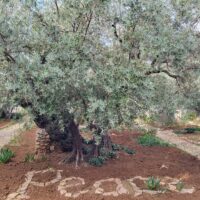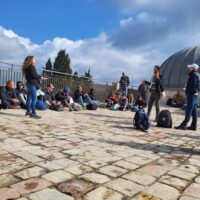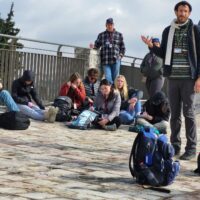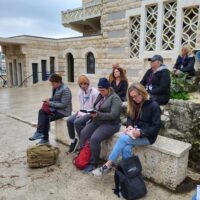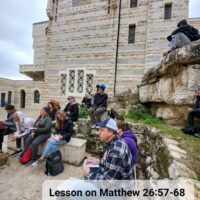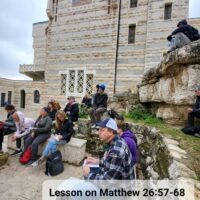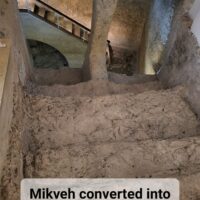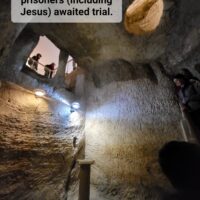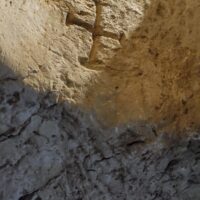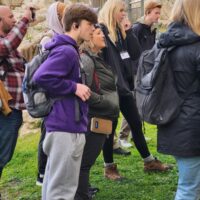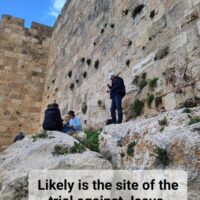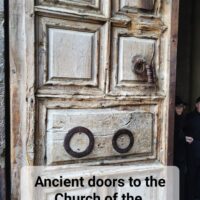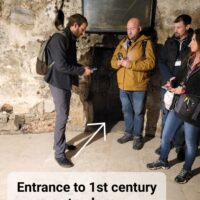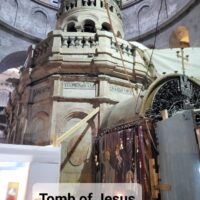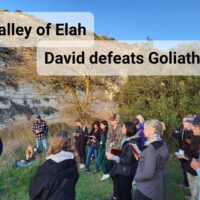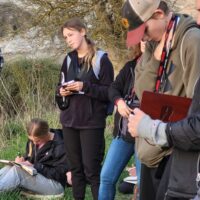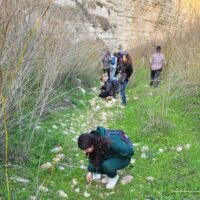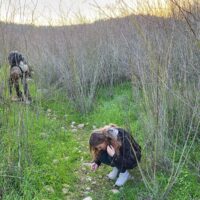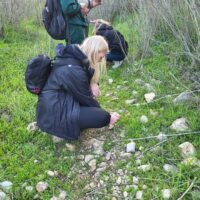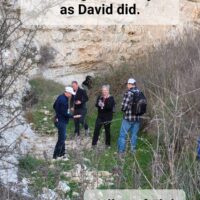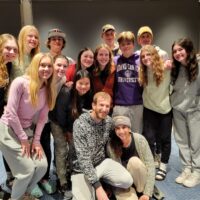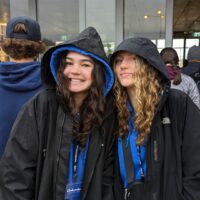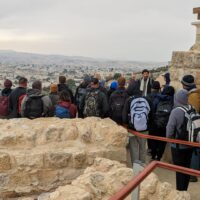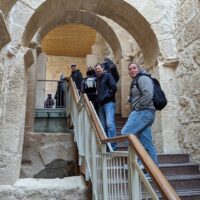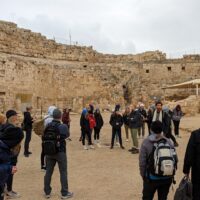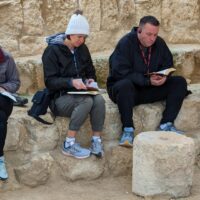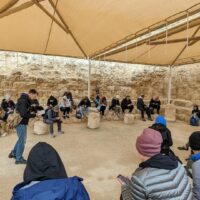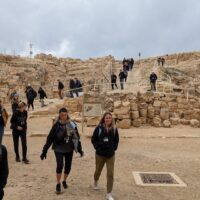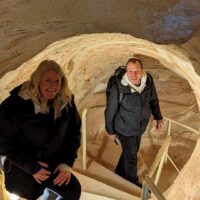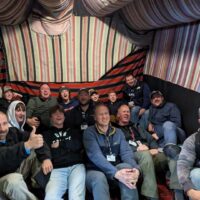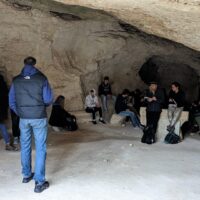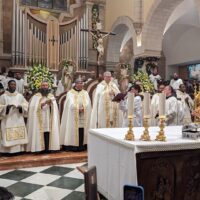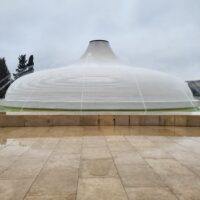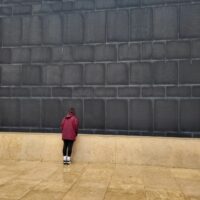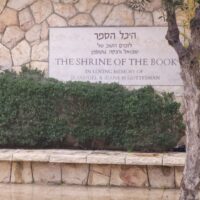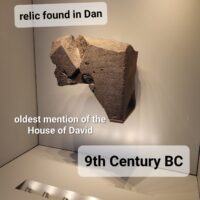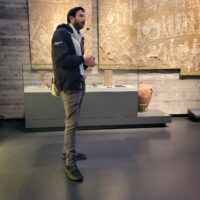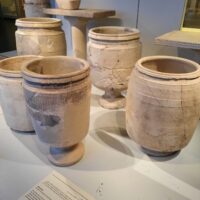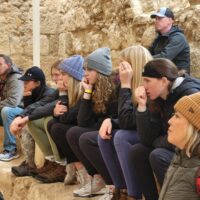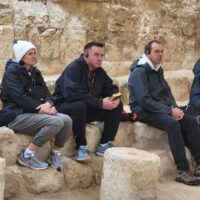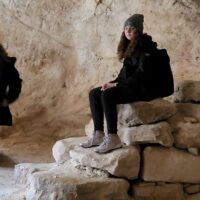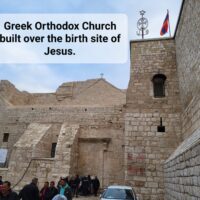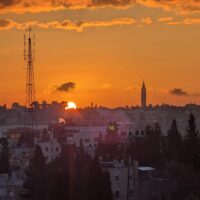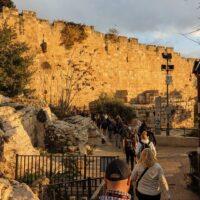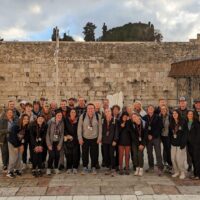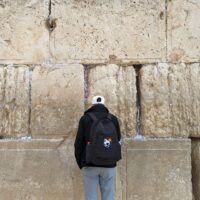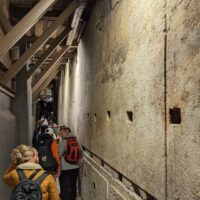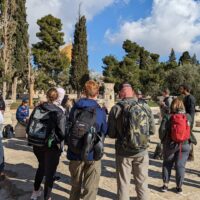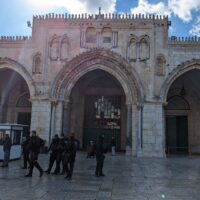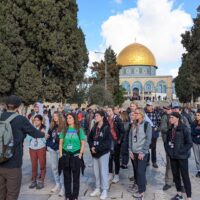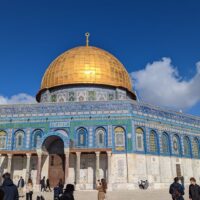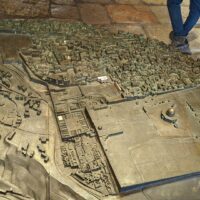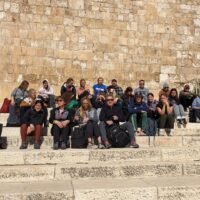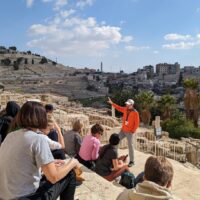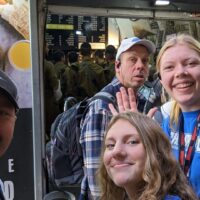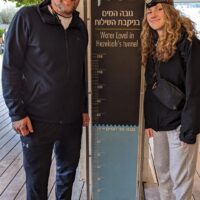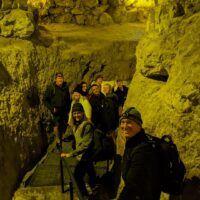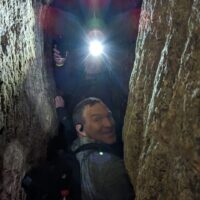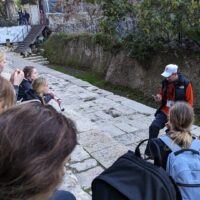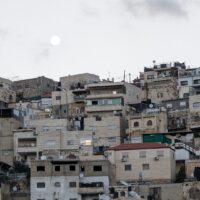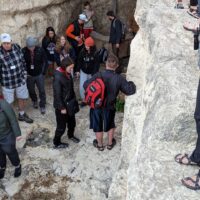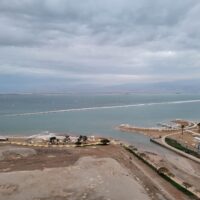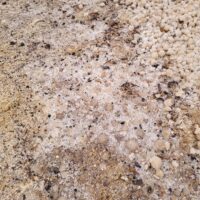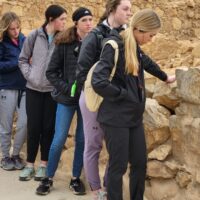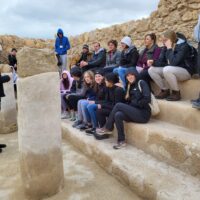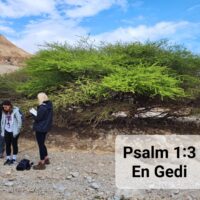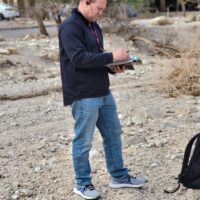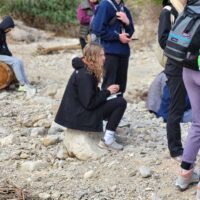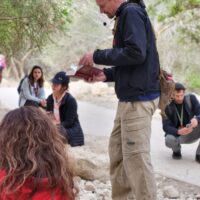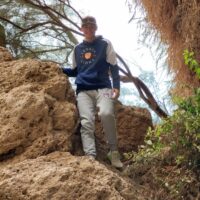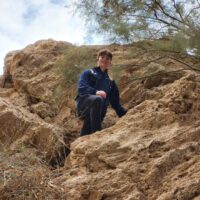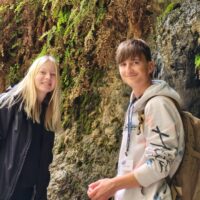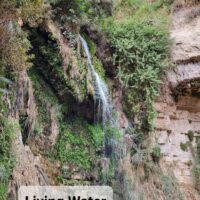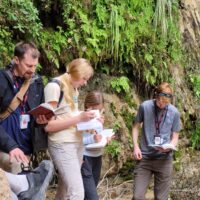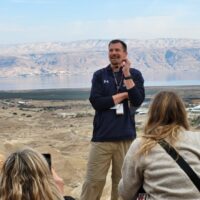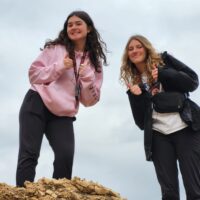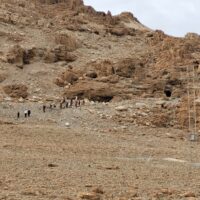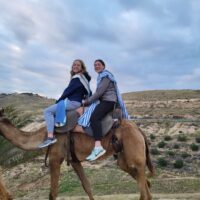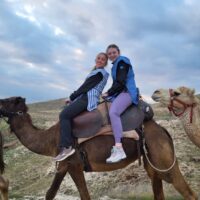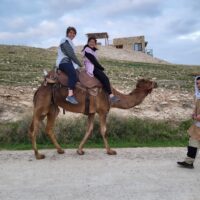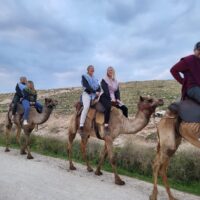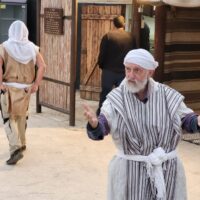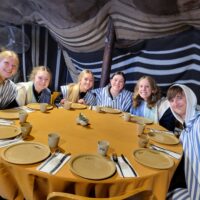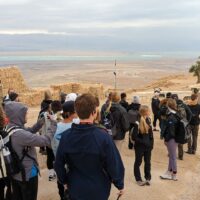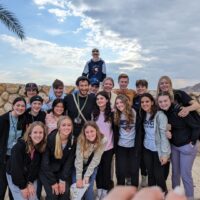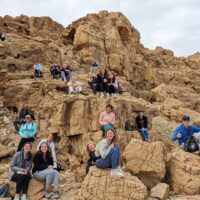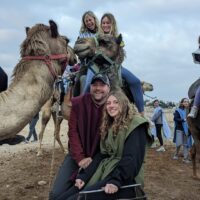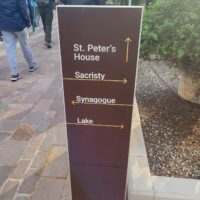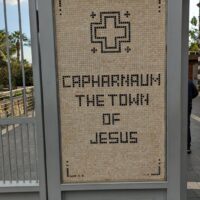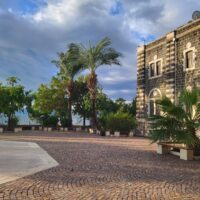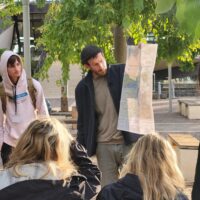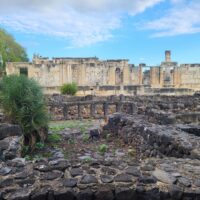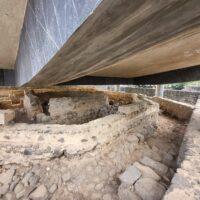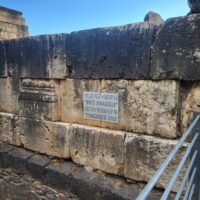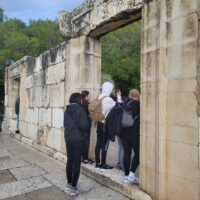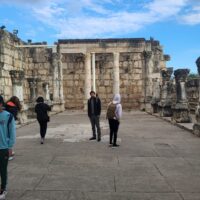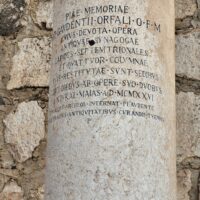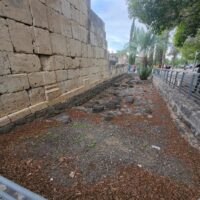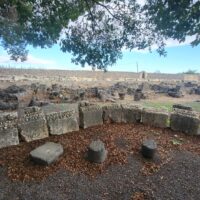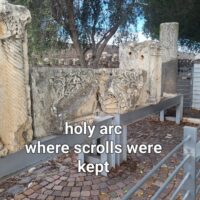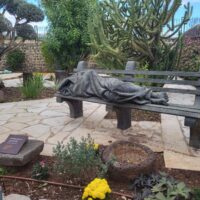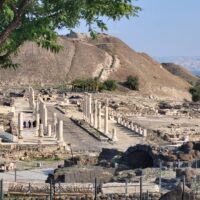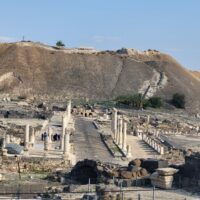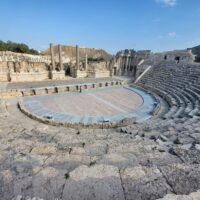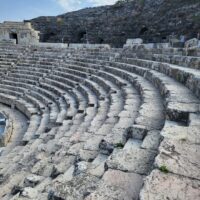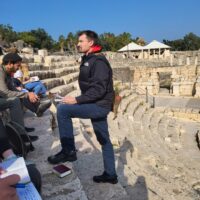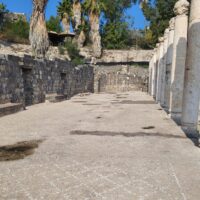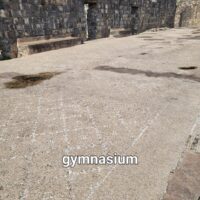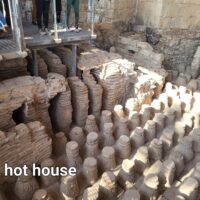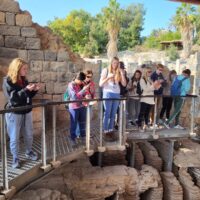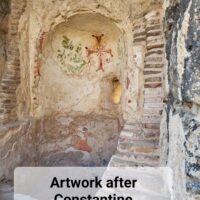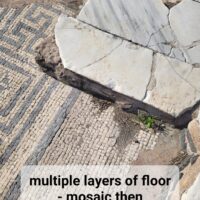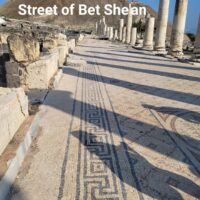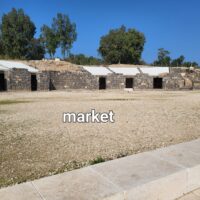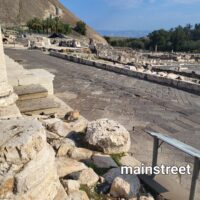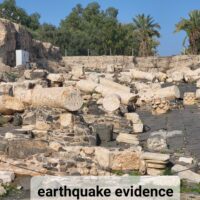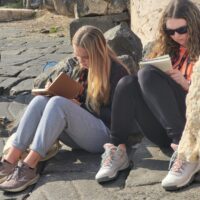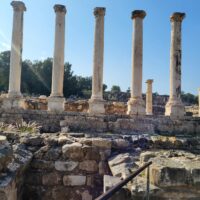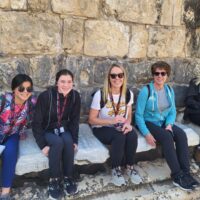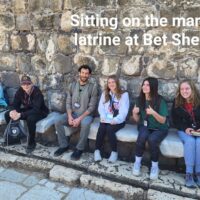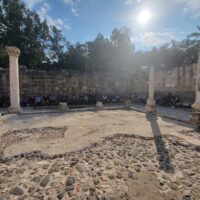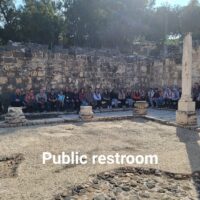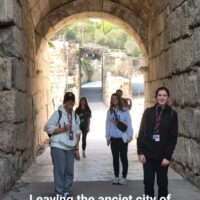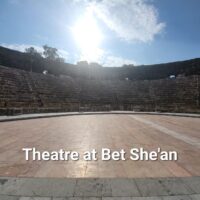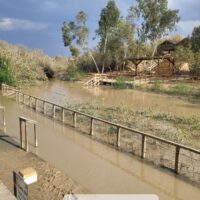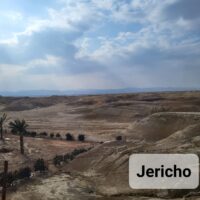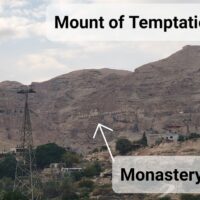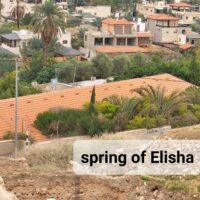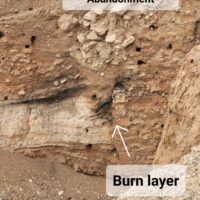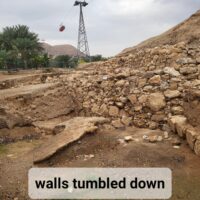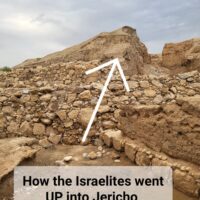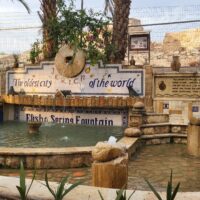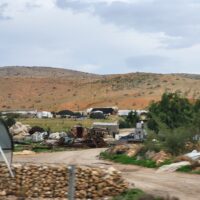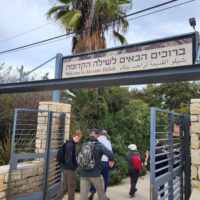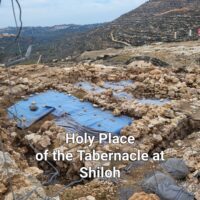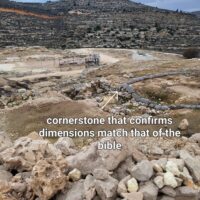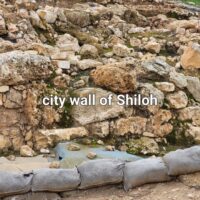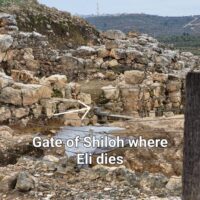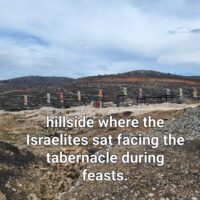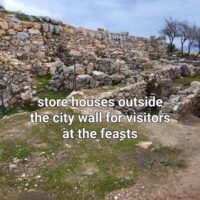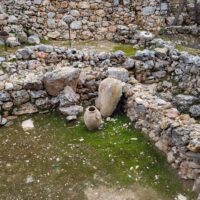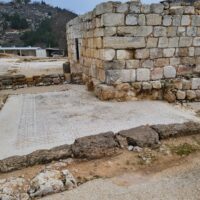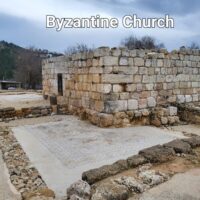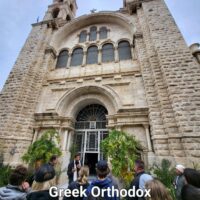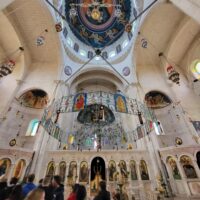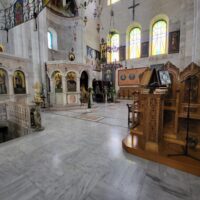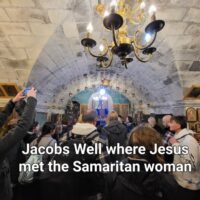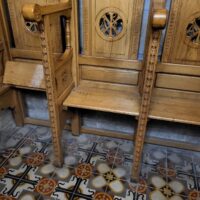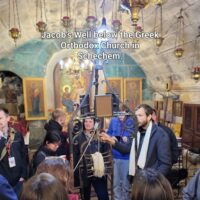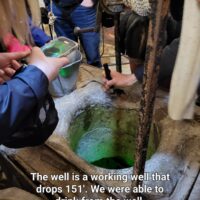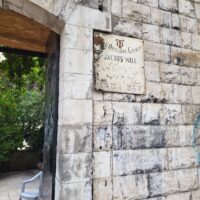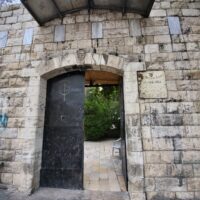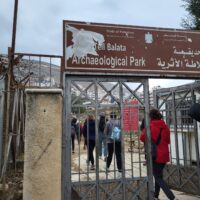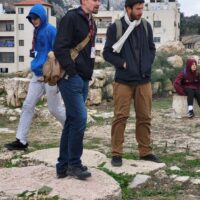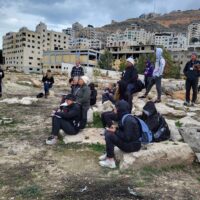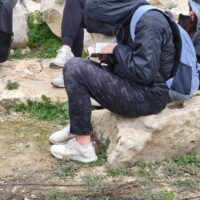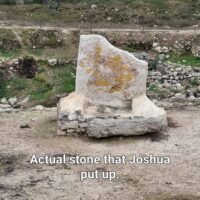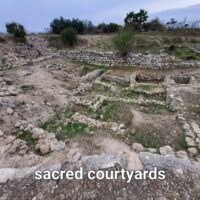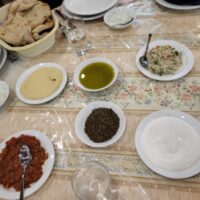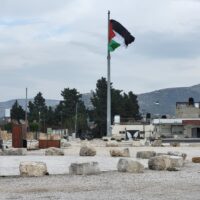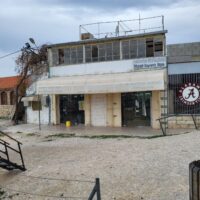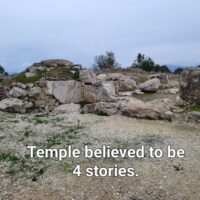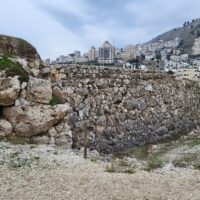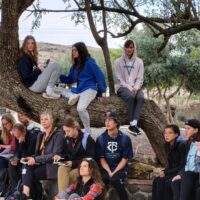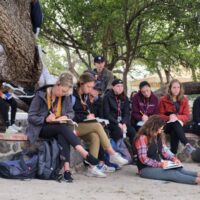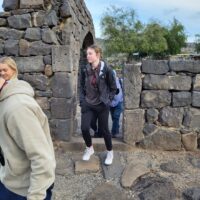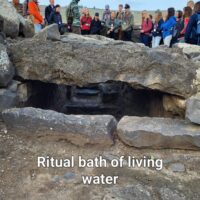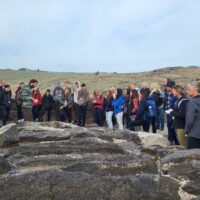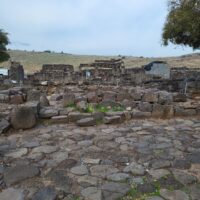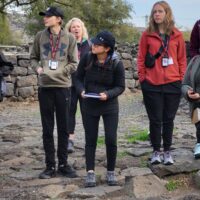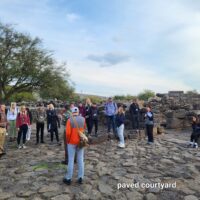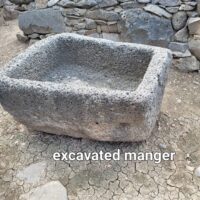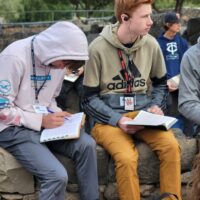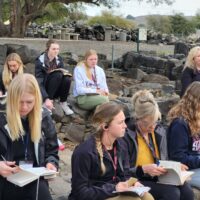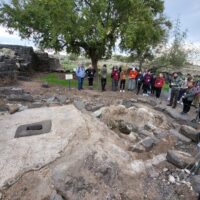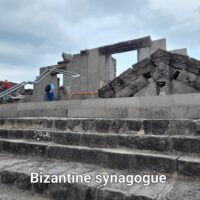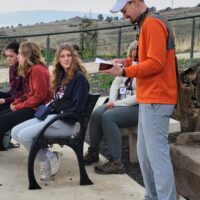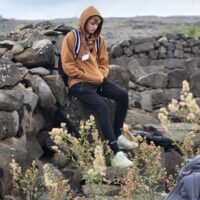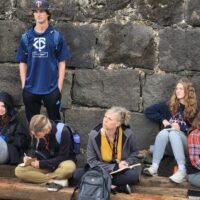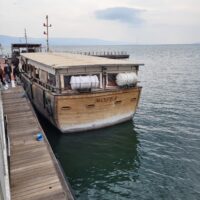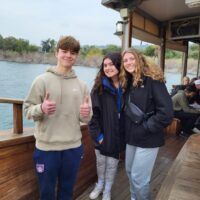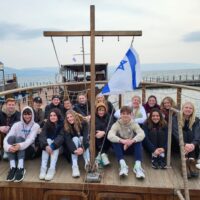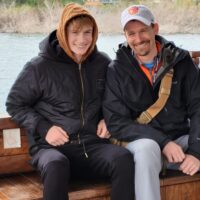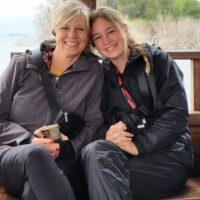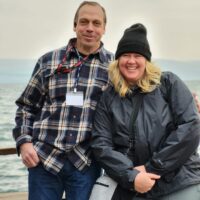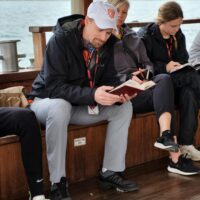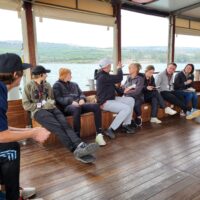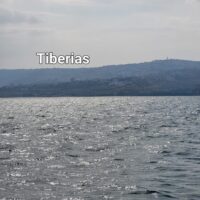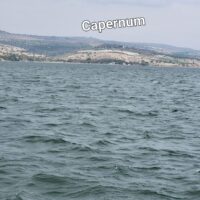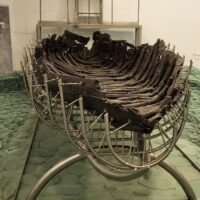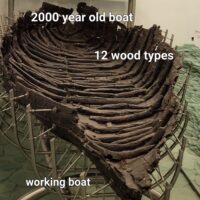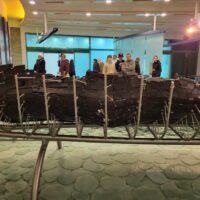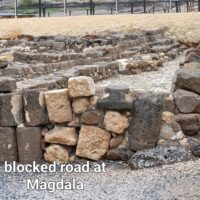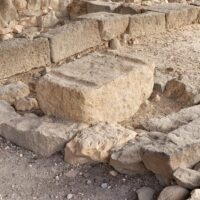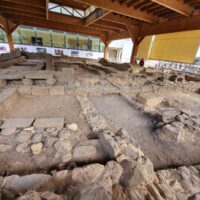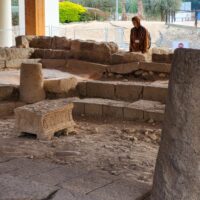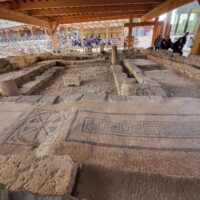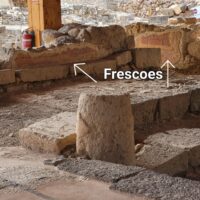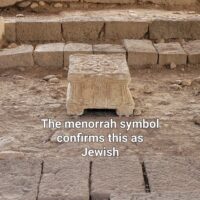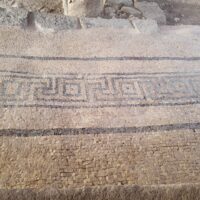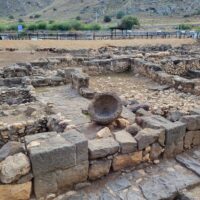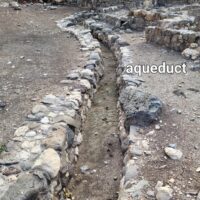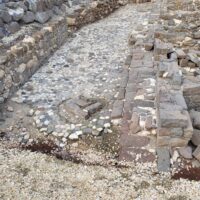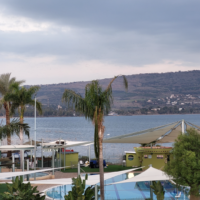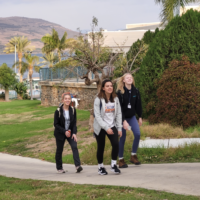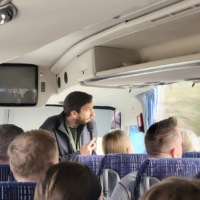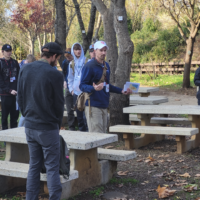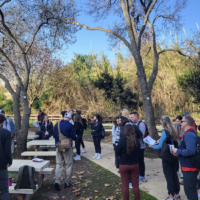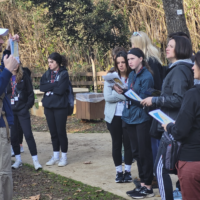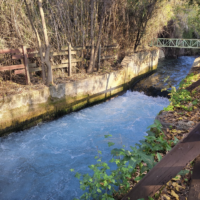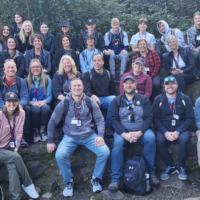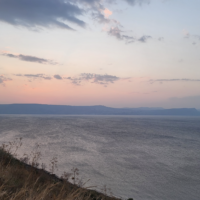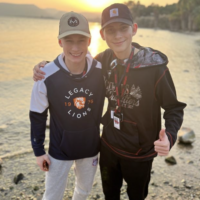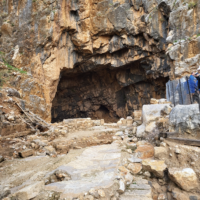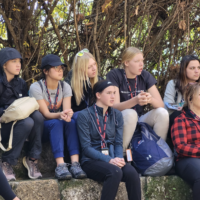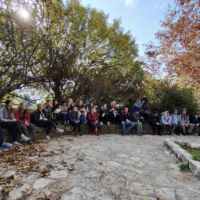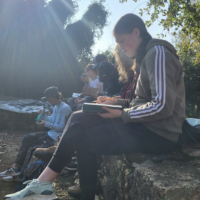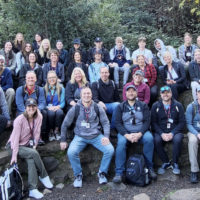The Best of Israel: 10 Day Tour 2023
A Special Thanks...
A huge thank you to our teachers on this trip. Our Head of School, Jake Mulvihill, is gifted in teaching the Word of God, and over and over again on this trip he connected the dots, traced the heritage back, and ultimately painted a picture to bring the Bible to life in new ways for each of us. We are so blessed to have his leadership and his wisdom available to us in our journey of faith here on earth. And Eschcar “the Guide”. A masterful storyteller and a deeply knowledgeable man of growing faith. His ability to weave his personal faith story from Jew to Christian throughout our trip was deeply moving. The respectful way he guided us through our trip, giving us the freedom to explore things of importance to us, was so appreciated. As they say, it was the trip of a lifetime.
Day 9: Mount of Olives, Garden of Gethsemane, Church of All Nations, Mount Zion, House of Caiaphas, Church of the Holy Sepulchre, Valley of Elah
Just like that, our biblical tour of Israel has come to a close. Today was so impactful as each stop along this trip has been leading to this moment. All of the background of understanding life in the 1st century was essential to walking through the fulfilled prophecies leading to the death & resurrection of our Lord and Savior Jesus Christ.
Starting at the Mount of Olives, through the Garden of Gesthemane, the last supper room, the House of Caiaphas, the Judgement Seat and crucifixion site at King Herod’s Palace, concluding at the site of his tomb (Church of the Holy Sepulchre).
In the Garden of Gethsemane at the Mount of Olives we read through Matthew 26, The Plot Against Him. This is the spot Jesus would come to pray and his final visit was filled with anguish. He knew what was coming and with all of His humanness, he called out to God to save Him if it was His will. (Matthew 16:39). His disciples with him, see him in his most human form. They needed to witness Jesus this way as proof, that though God, he was also man. He expressed his pain fully to the Lord so that He could summon what was needed to follow through with the events of the coming days. We too need to express our feelings fully to God. Not for Him, but for ourselves. Expressing our emotions, all created by God, gives us His strength to carry on with the purpose He has put on our hearts. There is no reason to hide from God, you can be real with Him at all times.
We stopped for a short reflective time of prayer at the Church of All Nations, built at Gethsemane as a place of remembrance for the events that occurred there: Jesus’ sweat blood, the kiss of betrayal, and his arrest.
Out of the Garden, we entered Mount Zion, an active synagogue that is also recorded as the place of the last supper. Here we focused on Jesus’ practice of “giving thanks”, “breaking bread”, “giving to the disciples” and “disciples giving to the people”. This is mentioned 3 significant times in the bible: Feeding of the 5,000 (Matthew 15:18-19), Feeding of the 4,000 (Matthew 15:36), and the Last Supper (Matthew 26:26). However, it’s important to note that in the Last Supper, the final step does not occur. This will later be fulfilled by the Great Commission. (Matthew 28)
Our next stop and lesson occurs at the House of Caiphas, high priest. Jesus was brought before Caiphas to defend himself of the charges against him, blasphemy. Here, Jesus, knowing what will come, doesn’t have to speak, but he does. He speaks truth in the face of persecution. “Yes, it is as you say.” (Matthew 26:64). We move on to see the cistern, Sacred Pit, where he was likely held prisoner until he could go on trial. Then we stop at the palace wall where Pontias Pilot would’ve approached the people from his judgement chair to save their king, Jesus. But the Jews don’t want Jesus saved and they send him to his flogging. The vivid description presented to us was emotional and raw. The lashings Jesus took, the pain that was inflicted upon Him, all to save us. He is a true King.
One final stop at the Church of the Holy Sepulchre, the place of Jesus’ tomb, concluded our walk. This church is heavily visited and deeply divided. The multitude of ways that Christians are worshipping here do not line up with what we know of Jesus. That the work is already done. There is nothing left for us to do. Jesus did it all on the cross. All we have to do is accept him as our Lord and we step into rightness with Him. He lives in us all the days of our lives.
Before leaving Jerusalem and Israel there was one more important site to visit. The Old Testament site of David and Goliath. One final lesson of God’s truth to unpack. Standing in the Valley of Elah, we are reminded of God’s intentionality in each of our lives. We are each gifted uniquely and when God calls us it is our gifts and talents he wants, not those of anyone else. David could not defeat Goliath with the armor of Saul, it wasn’t his gifting. He defeated Goliath with a sling and a stone, exactly as God had prepared him as he shepherded the sheep. Don’t be fooled by feelings of shame or condemnation. Those are from Satan. God wants to lift you up or prune you so that you can continue to bear fruit in His Kingdom. (John 15) If you don’t know where to start, open the pages of the most beautiful letter ever written, the Holy Bible, and abide in Him.
She-ma Yisrael, Adonai Eloheinu, Adonai Echad.
Hear O’ Israel, the Lord is our God, the Lord is One.
Day 8: Jerusalem
Another day in Jerusalem was another day of experiencing new things, learning more about the history of the Israel nation, and seeing God’s amazing message throughout the Bible.
The day began with our first consistent rain of the trip, but that didn’t stop us. We threw on our rain gear and headed to the Israel Museum. This place includes the world’s most comprehensive collections of the archaeology of the Holy Land, and Jewish art and life. Our first stop was outside at a scale model of Jerusalem. This model reconstructs the topography and architectural character of the city as it was prior to its destruction by the Romans in 66 AD.
From there we stopped at The Shrine of the Book. This monument houses the Dead Sea Scrolls, the oldest biblical manuscripts in the world, as well as rare early medieval biblical manuscripts. The scrolls were discovered in 1947–56 in 11 caves in and around Qumran. This was an awesome connection to when we saw a few of the caves earlier in the trip.
After that, we headed into the main part of the Museum to check out many artifacts proving the existence of people and events found in the Bible!
We kept the day moving by heading to the Herodium. As we saw in Masada, Herod was considered one of the greatest builders of his time and was not deterred by the geography of the land. According to the Roman Jewish historian Josephus, Herod “built a town in commemoration of his victory, and enhanced it with wonderful palaces… and he called it Herodion after himself”. Here Jake talked about the man, King Herod the Great. Herod was all about himself and spent his whole life building up earthly treasures that we see have passed away. Herod also was part of the birth of Jesus when the Magi came and visited him asking for the King of the Jews. Herod then killed all baby boys 2 years old and younger because he felt challenged against his reign of what he stood for. Herod pointed all to himself. The baby Jesus pointed to God. Herod believed he was the way. The baby Jesus was the way. Herod wants all to come to him to see his splendor. The baby Jesus wants all of us to come to Him to know Him. In the end, baby Jesus won and has won.
Next, we moved on to lunch and experienced another great meal. The restaurant was in Bethlehem. The team enjoyed kabobs and an array of salads, fresh hummus with bread, and a delight to many of the students, French Fries.
Just a short walk from the restaurant was our next stop in Bethlehem. Jake and our guide led us to a cave on the hills of Bethlehem. There Jake taught another lesson about seeing Jesus from Genesis to Revelation. We read the passage of Luke 2 together and asked the question, why the shepherds? The shepherds during the time of Christ were the lowly of the low people. They were not allowed to be a witness or testify in court nor were they allowed to go into the temple because they were considered unclean. But who did God send the message of Jesus to first? It was the shepherds. They were given the role and job to testify and witness the first moments of Jesus and were the first to worship Him. Jesus was beginning to show that He is the way! Also, the shepherds of that time would also look for the unblemished lambs that were born. To keep that lamb unblemished, they would wrap that little lamb in tight cloths and place it in a manger until it was time for the lamb to be sacrificed. What did the Lamb of God do when he humbled himself to come to earth? He was wrapped in tight cloths and placed in a manger. We ended our time in the cave singing Away in Manger together. Wow!
As our day ended, we headed to the Church of the Nativity. It holds a prominent religious significance to many as the birthplace of Jesus. This is the oldest site continuously used as a place of worship in Christianity. The unique part of this experience was that today was the celebration of the Orthodox Christmas.
We went to bed knowing that tomorrow’s journey will be tracing the last days of Jesus. May we ever give God the Glory for the greatest sacrifice, Jesus, His Son.
She-ma Yisrael, Adonai Eloheinu, Adonai Echad.
Hear O’ Israel, the Lord is our God, the Lord is One.
Day 7: Jerusalem
We woke up this morning to a beautiful sunrise over Jerusalem as we ate breakfast on the top floor of our hotel. We knew that today would be a special one being our first full day in the city with so much history.
Taking off at 7:15 from the hotel didn’t mean that we wouldn’t avoid the business and packed streets of Jerusalem. Tam, our bus driver, navigated the roads with precision getting us safely to our destination. Our first stop started on the southern side of the Temple mount.
After passing through security, the first stop was the Wailing Wall. Being it was early in the morning, we were able to walk up to the wall and share our hearts with the Lord. Our guide had encouraged us to write a prayer out last night on a small piece of paper and share that with Adonai while at the wall. After talking with Our Father, many of us left that prayer in a crevice of the wall like hundreds of thousands of people before us have done.
From there we learned about the construction of the Temple from Solomon to Herod and saw the amazing construction feats of the people of that time. We were all amazed at the size of the stones that were quarried and moved into position, some estimated to weigh over 900 tons.
As we walked back out down the streets of Jerusalem we saw and heard many new things like the Israeli army was swearing in many of their new soldiers, a bar mitzvah with joyous celebration, the Muslim call to prayer echoing through the hills and valleys, and the hustle of the streets with the Jewish people and Muslims heading to the mount to worship.
With all that in mind, we headed to the top of the Temple mount. Now controlled by Muslims, the Temple mount is now dominated by the Dome of the Rock. This symbol of the Muslims and the Islam religion is believed by many Muslims to be the site mentioned in the Qur’an, which tells the story of the Isra and Mi’raj, the Night Journey of Prophet Muhammad from the Great Mosque of Mecca to the Masjid Al-Aqsa (‘”the farthest place of prayer”) where he prayed, and then to visit heaven where he leads prayers and rises to heaven to receive instructions from Allah. This is all built where God’s Holy of Holies was once built.
With a bit more walking, we stopped at the southern wall and sat on the steps to the entrance. From here we could see Mount of Olives, the Garden of Gethsemane, the City of David, and the Kidron Valley. We were all admiring the beauty of the area as well as trying to recreate in our minds what the land looked like from 1000 BC (David) to the time of Jesus. Here Jake shared the story of Pentecost and how God came out of the Temple to dwell in us. 1 Corinthians 6:19 states, “Do you not know that your bodies are temples of the Holy Spirit, who is in you, whom you have received from God?” If we believe that we are God’s temple, how are we showing that to the world? How are we using our God-given abilities to bring Him glory and bring people to experience His salvation?
From here, we headed to a street lunch with vendors selling very traditional Israeli food. We took some time to shop in the Bazaar and then continued to our next site.
We took some time to learn about the many clay seals that had been found that matched with names of people in the Old Testament. I believe we all have thought of coming to the conclusion that it is harder to believe that the Bible false than to believe it is true. We stepped through David’s palace and stopped to talk about Hezekiah, a king of Judah 275 years after David. Hezekiah followed the ways of the Lord and remained true to God rather than follow the idols of the time. However, a huge problem was coming. The Assyrian army of 185,000 men were destroying Judah and Jerusalem was the last stand. As Hezekiah learned of the destruction that would be coming in the future year, he first prayed to the Lord and asked for deliverance and secondly he did all he could with his influence as king. One thing that he did was dig the Hezekiah tunnel. As the Bible tells us, the 533-meter-long tunnel was dug by King Hezekiah so that he could fortify the city against the invading Assyrian armies without compromising its main water source, the Gihon Spring, which lay outside the walls: “And when Hezekiah saw that Sennacherib was come, and that he was purposed to fight against Jerusalem, He took counsel with his princes and his mighty men to stop the waters of the fountains which were without the city: and they did help him. So there was gathered much people together, who stopped all the fountains, and the brook that ran through the midst of the land, saying, Why should the kings of Assyria come, and find much water?” (2 Chronicles 32:2-4).
Our challenge here was to pray to God for His will and humble ourselves before Him, and also do what we can in the roles God has placed each of us.
With that in mind, we slipped on our water sandals, shoes, or boots, changed into shorts and headed down Hezekiah’s tunnel! Check out some of the pictures below. At the end of the tunnel where the water emptied is where the Pool of Siloam. The blind man washed the mud off of his eyes in this pool and received his sight (see John 9). When reading this passage, we see that the disciples and others thought the blindness was because of sin in the family line. Jesus, however, said that was not the case but rather the works of God would be displayed through this man. Our challenge was when suffering and hard things come in our lives, do we focus on the conditions of hardship or do we focus on how God may use those circumstances to draw us closer to Him?
Our last stop on this busy day that saw us walk almost 6 miles was a new site for everyone on this trip. This was the Tomb of David. Now this wasn’t the traditional Tomb of David that previous Israel Tours have visited. Rather this is a site that Jake has been researching and following some prominent archaeologists who point to this site as David’s tomb.
As we closed the day, we were reminded of all the amazing ways that God’s hand has been continually on His people.
She-ma Yisrael, Adonai Eloheinu, Adonai Echad.
Hear O’ Israel, the Lord is our God, the Lord is One.
Day 6: Masada, En Gedi, Qumran
We woke up this morning and a group of more than 15 headed down for a sunrise float in the Dead Sea. After an amazing breakfast we headed out to Masada.
Masada is an ancient fortification in the Southern District of Israel situated on top of an isolated rock plateau. According to Josephus, an early Jewish historian, between 37 and 31 BCE, Herod the Great built a large fortress on the plateau as a refuge for himself in the event of a revolt, and erected there two palaces, with an endless supply of food and water. We traveled by cable car up to the snake entrance more than 950 ft above the starting point. At this site we learned of the rise and fall of Masada. The cry of the Jewish people is Masada will never fall again.
From Masada, we traveled a short distance to En Gedi. As we started to learn about this site, Jake pointed out the acacia tree along the side of dried-up ravines. Being in the desert this tree finds its water by having deep roots to store water throughout times of drought. Even in the summer heat of the desert (up to 120 degrees) this tree can have green leaves. In Psalm 1 David writes, [2] But his delight is in the law of the LORD; and in his law does he meditate day and night.
[3] And he shall be like a tree planted by the rivers of water, that brings forth his fruit in his season; his leaf also shall not wither; and whatsoever he does shall prosper. Our challenge was how do we delight in God’s Word as to be like the acacia tree. We continue up the trail in En Gedi and ended at an amazing waterfall above a cave structure. Jake challenged us to think about the times Jesus talked about being the Living Water for us. This cave was also where historians believe the story of David cutting a piece of Saul’s robe (tassel) while he was in the cave occurred. This was tied back to previous lessons on the tassels (tzitzit) that we learned.
After lunch, Jake had a surprise for us. We hiked up the side of a rocky area to a small cave and an outcropping of rock. We saw this small cave and took pictures of it, not realizing the historical significance of this place. Jake gathered us and spoke about how in this cave, and 10 others in the area, the Dead Sea Scrolls were found. In those scrolls, each Old Testament book has been found either in portions or in its entirety. When people debate whether God’s Word is real, these recordings of what we have now in our Bibles match up to 99.9% accuracy. Amazing.
Then in what was a heart-touching and powerful message, Jake shared the story of his mother, Jane Mulvihill. He shared of her love for God, her love for His Word, and her love for her family. Jane Mulvihill went to be with her Savior in 2008, dying at the age of 54 due to ALS. Jake shared a portion of a letter she wrote to him before her passing. With tears in many of our eyes, he challenged us with the Love letter God has written for us that we all have access to, His Word, the Bible. If we have this great letter in our possession, do we love it? Do we spend time reading it? Do we share it with others? God has gifted Jake with the amazing ability to use what the world would call a tragedy to show how God loves each one of us deeply.
Lastly, we traveled toward Jerusalem to a place called Genesis land. There we were able to experience a reenactment of Abram near a top of a mountain range overlooking the valleys on either side. Somewhere close by is where Abram and Lot would have chosen the land that they were going to inhabit. Here we were able to experience riding camels in pairs and eating a traditional meal of the time.
Tomorrow we head into Jerusalem to see and learn about more ways that the Bible continues to show us its historical accuracy while also showing us God’s amazing plan for you and me. God loves us. God sent his Son. His Son died for you and me. His Son is life! His Son is victory! His Son is Jesus the Lord!
She-ma yisrael, Adonai Eloheinu, Adonai Echad.
Hear O’ Israel, the Lord is our God, the Lord is One.
Day 5: Capernaum, Bet She'an, Jordan River, Jericho, Dead Sea
Today we packed up to leave the beautiful Sea of Galilee. Before we headed south to Jerusalem we had two last stops on this north end. Capernaum and Bet She’an.
Capernaum is at the north end of the Sea of Galilee. It is here that Jesus called Peter and where he did much of his teaching. There is archaeological evidence of a synagogue beneath a synagogue. It is believed that this is the synagogue Jesus taught out of. After following Jesus, Peter returned home to Capernaum and began to spread the word. Given Capernaum’s connection to both Peter and Jesus, its location, and these archeological findings many believe it is the birthplace of Christianity.
Bet She’an is a large ancient Roman city. We sat in the theatre and discussed the entertainment of the time. We are living in a similar culture where we can entertain ourselves to death. Another point of interest visible here was the enormous bathhouse that included gymnasiums, hot houses (saunas), and multiple bath pools. What was not evident at Bet She’an was any sign of God. This was a city Jesus prepared the disciples to go to, but not where the disciples were called from. The challenge to those who call themselves Christian is to embrace the habits of Jesus, not the habits of our world. The habits of or world focus on self and entertainment, whereas Jesus’ habits included prayer, solitude w/ God, teaching and community.
At the Jordan River in Jericho, we discussed the importance of taking a step of faith. The priests had to first take a step before God stopped the river from flowing. (Joshua 3) We too must take steps of faith in order to see God work in our lives. We had a time of sharing personal “step of faith” stories here along the Jordan River.
Moving on we had another amazing lunch at The Green Valley. The meals here have truly been a treat.
After lunch we finished our time in Jericho by visiting the actual walls that came tumbling down after Joshua led the Israelites in their 7-day march. You can see where the fall of bricks from the wall created a ramp into the city. (Joshua 6:20) You can see the burn layer and abandonment layer which are evidence of Joshua burning the city to the ground and NOT rebuilding on top. (Joshua 6:24-26) Here there is also evidence of the spring that Elisha restored after receiving a double portion of Elijah’s spirit. (2 Kings 2:21-22) The natural spring is still supplying the city of Jericho today.Despite rolling into the Dead Sea at sunset, our crew closed out day 5 experiencing the fascinating effects of this 33% salt body of water. Incredible! Many experienced both the spa salt waters of the local hotel as well as floating in the Dead Sea itself.
Day 4: Ancient Shiloh, Shechem
Today was cold and windy, but we still made it to 2 of our 3 planned sites. We traveled south from Galilee to Shiloh and Shechem. During our time on the bus, our guide shared with us about Israel history and present day operations.
Today we had the rare opportunity to visit a new Archeological site in Shiloh. The findings here were just opened this year. What they have unearthed is truly the ancient city of Shiloh. To see the foundation of the tabernacle that Joshua had put up at Shiloh and the gate where Eli died (1 Samuel 4:18) in fulfillment of God’s word (1 Samuel 3:12) was truly exciting.
Next up…Shechem
In Shechem, we first visited Jacob’s Well where Jesus met and spoke with the Samaritan woman. The well is within/below a beautiful Greek Orthodox Church. It is a working well that drops 151′; many of us drank from the well.
We then moved down the street to the ancient temple of Joshua. A fortress city with high walls made of mud and large rocks. Here we learned about ancient covenants and specifically God’s covenant with Abraham. (Genesis15).
Joshua also made a covenant at Shechem (Joshua 24) and marked it with a large stone that still stands today. Joshua’s covenenant was made to record the peoples announcement that they would choose God (Joshua 24: 15-26). The challenge for all of us is to answer the question “what god will you choose?”. We all choose one. When you worship your culture over God you invite hardship into your life and to the life of your children. We closed our time at Shecham discussing what it means to have faith. Ancient peoples had to have faith in what was to come, today we are called to have faith in what was.
Our guide took us to a delicious lunch in Sabista, Palestine. We had so much fun with our gregarious host and the meal was full of amazing flavors. Best yet!
We intended to end our day at Nazareth Village to enjoy a re-enactment of Jesus boyhood home, but spent a few extra minutes getting back into Israel which put us behind schedule. All good – the kids had a little more downtime together. Tomorrow we leave Galilee and head south to Jerusalem!
Day 3: Chorazin, Jesus Boat, Sea of Galilee Cruise, Magdala
Another amazing day today in the Galilee region.
First stop was at Korazim. Here we learned about how 1st century people lived and what homes were like. Jake shared an awesome lesson about the prodigal son and how Jesus desires an intimate relationship with us. He shared about the bride and the bridegroom and the pictures throughout the teachings of Jesus to point to that relationship. (John 14:1-4, John 15:16, I Cor 6:20)
We also learned about the Rabbi and talmid (teacher and student) relationship. We learned that Jesus reversed that model and rather than the student (talmid) asking the teacher (Rabbi) if they could follow and learn from them, Jesus called and chose his disciples. We were challenged on how can others follow our example as we follow the example of Christ?
From there we got on a boat and traveled on the Sea of Galilee. We sang worship songs and then the guide led us in an Israeli dance.
We arrived at a museum with an excavated 1st century boat. This boat would have been what Jesus and his disciples used while on the Sea of Galilee.
After this we headed to a restaurant where many of us ate a whole St. Peter’s fish (tilapia), that is the type of fish in which Peter found the coin to pay the temple tax.
Then we headed to Magdala. This is the town from which Mary Magdalene was from. Here we saw a synagogue that Jesus would have taught from. The rock was carved to hold the scrolls as the Rabbis read and taught from the Torah. Jake also taught about the woman who touched the tassels (tzitzit – wings) of Jesus’ robe and was healed. Some amazing correlation to Malachi 4:2.
Lastly we headed up to the traditional place where the Sermon on the mount could have taken place. We spent some time individually reflecting and then shared our hearts with our group. Amazing time of community and hearts full of the goodness of God and the love that Jesus has for us.
We are in awe of our Savior. His agape for us. His amazing plan. His desire for relationship with His children. God so loved the world …
Day 2: Dan, Caesarea Phillippi, Galilee
We began day 2 in the beautiful Tel Dan Nature Reserve. Ancient Dan was a place of evil pagan worship. This is one of the sites where Jereboam introduced a counterfeit worship system by constructing a high place that included a golden calf for worship, telling the Israelites that Jerusalem was too far for them to go to worship. (1 Kings 12:28)
Here we learned of the Man of God who was the only one to speak against this sin. (1 Kings 13) We never learn his name, but we acknowledge that he did what was asked of him – speak the truth. He shared “A son named Josiah will be born to the house of David. On you he will sacrifice the priests of the high places, who now make offerings here…” However, Josiah doesn’t come for 300 years.
The important lesson for us here was that sometimes we are the Man of God and simply asked to speak the truth; other times we are Josiah and we have the opportunity to influence our immediate culture. In either case, we are able to do this through the Holy Spirit that lives in us. Jesus gives us what we need when we are called upon, simply by living for Him today.
Next we visited Caesarea Philippi. We learned that this area was a place of worship for the pagan gods Pan and Zeus. There was a cave at this site that was named the Gates of Hades. It was used to offer sacrifices to these gods. Jesus brought the disciples here for them to see and witness how awful the pagan worship had become and to reveal himself. Simon Peter addresses him as the Christ. It is here that Jesus shares with them “…and on this rock I will build my church and the gates of Hades will not overcome it.” (Matthew 16:18) If Jesus could overcome this evil, he had to be God.
Before sunset we spent a quiet time of teaching at the North Shore on the Sea of Galilee where Jesus spent much of his time with the disciples. Imagine standing on the shore were Jesus stood and seeing Peter 100 yds out fishing. “Come, follow me,” Jesus said, “and I will make you fishers of men.” (Mark 1:17) This site was life changing for the disciples Jesus called. We studied 1 Kings 17 and the triumph and fall of Elijah. The lesson here is that Elijah was still just a man. He experienced fear and sadness just as we do. God does for Elijah then exactly what he offers to us today: God comes to him, he gives him purpose and a community of support. We are in Gods will by following him continuously. Ask yourself, are there areas of your life that you are not being honest with God. What are we denying about ourselves?
We closed out our day at the Nukeib Lookout, thought to be the site where Jesus healed the Demon-possessed man. We could see the tombs where the demon-possessed man could have stayed, the hillside where the pigs were feeding, and the sea where those pigs would drowned after Jesus gives the demons permission to to go into them. The Demons knew who Jesus was. They knew his power over them. This all happened on the “other side” which we have learned is a reference for when Jesus was in the Decapolis amongst gentiles. The demon-possessed man was then sent by Jesus to share the story of how he was saved and all the people were amazed. (Mark 5:20) As are we!
Day 1: Caesarea
Thirty-five LCA community members left Minneapolis at 6:00 am on Thursday, December 29th, and arrived in Tel Aviv, Israel at 9:30 am on Friday, December 30. Israel is 8 hours ahead. We were tired, but eager to explore this homeland of Jesus. The adventure began the moment we got on the tour bus at the Tel Aviv airport. We met our tour guide Eshgar and our driver Tam and began to get some background on Israel. It was important to note that we were on a tight time schedule due to Shabat starting at sundown, so there was no time to waste! We headed north to Caesarea!
Our first stop was at the Port Café in Caesarea on the coast of the Mediterranean Sea for lunch. The view was amazing and the food fresh and delicious. Revitalized, we stepped back into time to explore the port city of Caesarea. Built by King Herod the Great to impress Julius Caesar, Caesarea was geographically located in prime real estate between Egypt and Greece. Our first lesson, studying the book of Acts, took place in the theatre, palace and hippodrome of Herod the Great.
We learned about the importance of Peter obeying God’s command to visit Cornelius (Acts 10-11). This action signified the beginning of Christianity being brough to the Gentiles.
As we stood in the hippodrome, we reflected on Paul’s commitment to share the gospel of Jesus to the ends of the earth (Acts 1:8). In Acts 23:25 we learn that Paul, still known as a Roman citizen, is taken before Governor Felix to defend himself in Caesarea. He is later transferred to Rome. We reflected on the cost to Christians, both then and now, for standing firm in their faith despite suffering in this world. We could imagine Paul, standing in that space, before the Roman High Priests, refusing to bow to anyone other than God and losing his life. This type of martyrdom was widespread in the 1st, 2nd and 3rd centuries, lasting over 300 years until Constantine proclaimed the freedom of religion in 313.
Some of the key takeaways from our group included:
- Jesus is God – all others are false.
- We were struck by the big and small ways that ancient leaders set themselves up to be seen as gods. From the way they built to the coins that marketed themselves as such.
- Upon understanding the way ancient peoples thought you became a god through ascension, it gave new significance to the importance of the 120 witnesses of Jesus’ ascension.
- The importance of preparation for the challenges of life. Preparation happens long before you ever need it.
Question for reflection:
What does it mean to be a follower of Jesus Christ? Specifically, what does it mean to be a disciple of Christ?
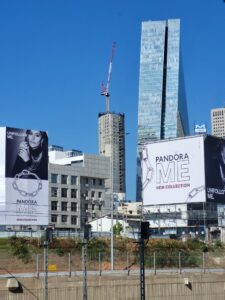
Tel Aviv
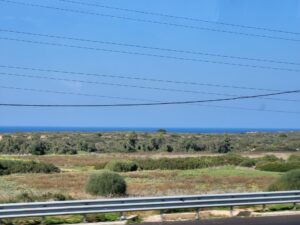
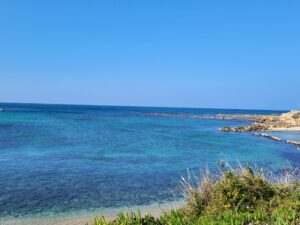
Mediterranean Sea
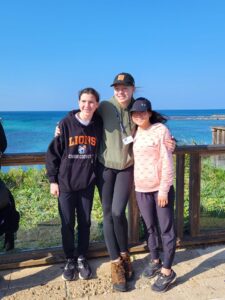
Bri, Rachel, and Anna at the Mediterranean Sea
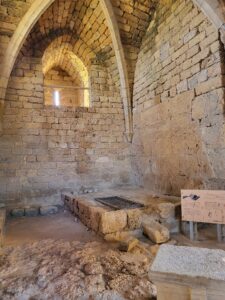
Crusader’s Gate at Caesarea
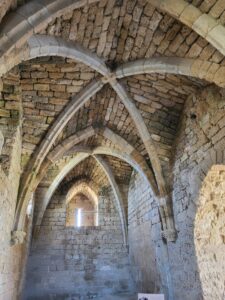
Ceiling of the Crusader’s Gate
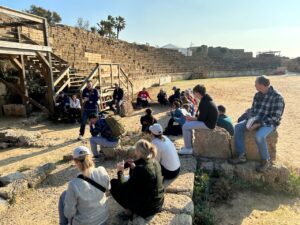
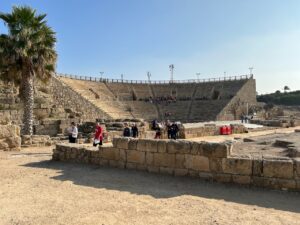
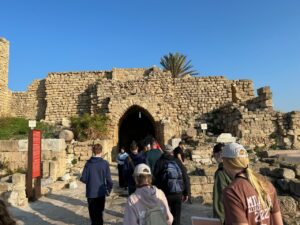
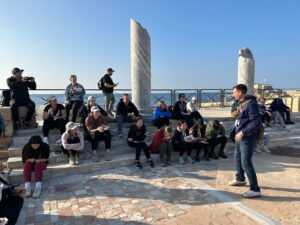
Herod’s Theatre
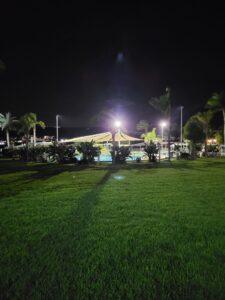
Good evening from the Sea of Galilee! It gets dark early! The sun sets before 5pm.
Welcome
From Thursday, December 29 through Saturday, January 7, 35 students, parents, teachers, and staff from Legacy Christian Academy will be traveling to the Holy Land of Israel on an intense, purposeful, and life-changing biblical history trip! During their travels through Galilee, Nazareth, Capernaum, Caesarea Philippi, Jericho, the Jordan River, the Dead Sea, Jerusalem, and the Mount of Olives, the group will be studying the Bible, not only in its original cultural, historical, and Jewish context, but also on site, walking where Jesus and His disciples walked. As the culture, history, and context of the Bible is unfolded in each location, students and adults alike will grow in their love for God’s Word, their love for Israel and the church, and marvel at the beauty of the unfolding of salvation history throughout the ages.
We invite you to join this team’s daily travels and teachings by visiting this blog page daily for news and pictures. We also ask you to please pray for God’s divine health, protection, and appointments on this trip!
Thank you so much! Shalom.
Itinerary
Dec 29: Travel to Israel
Dec 30: Arrive in Israel, Lunch provided, Caesarea Maritime
Dec. 31: Kursi, Caesarea Philippi, Dan, Mt. Bental
Jan 1: Chorazin, Capernaum, Jesus Boat, Sea of Galilee Cruise, Magdala
Jan 2: Shiloh, Shechem , Nazareth Village, Cove of the Parables and Tabgha Falls for an evening bonfire
Jan 3: Beth Shean, Jordan River Baptism site, Jericho, Dead Sea Float
Jan 4: Masada, Ein Gedi, Qumran, Abraham’s Tent
Jan 5: Temple Mount, Wailing Wall, Rabbinical Tunnels, Davidson Center/Southern steps, City of David, Hezekiah’s tunnel, David’s Tomb, shopping at the Jewish Quarter market or David’s Street.
Jan 6: Israel Museum, Yad Vashem, Herodium, Bethlehem Shepherds Cave, olive wood factory
Jan 7: Garden of Gethsemane, Kidron Valley, Church of the Apostles, Caiphas House, Herod’s palace, Church of Holy Sepulcher, Valley of Elah, Vineyard/tomb at Kir Bet Midrash
Jan 8: Return to the United States



